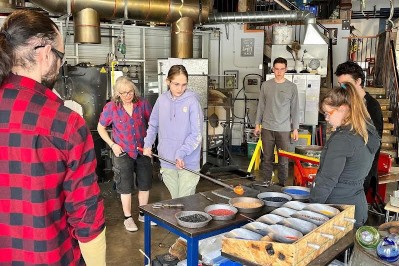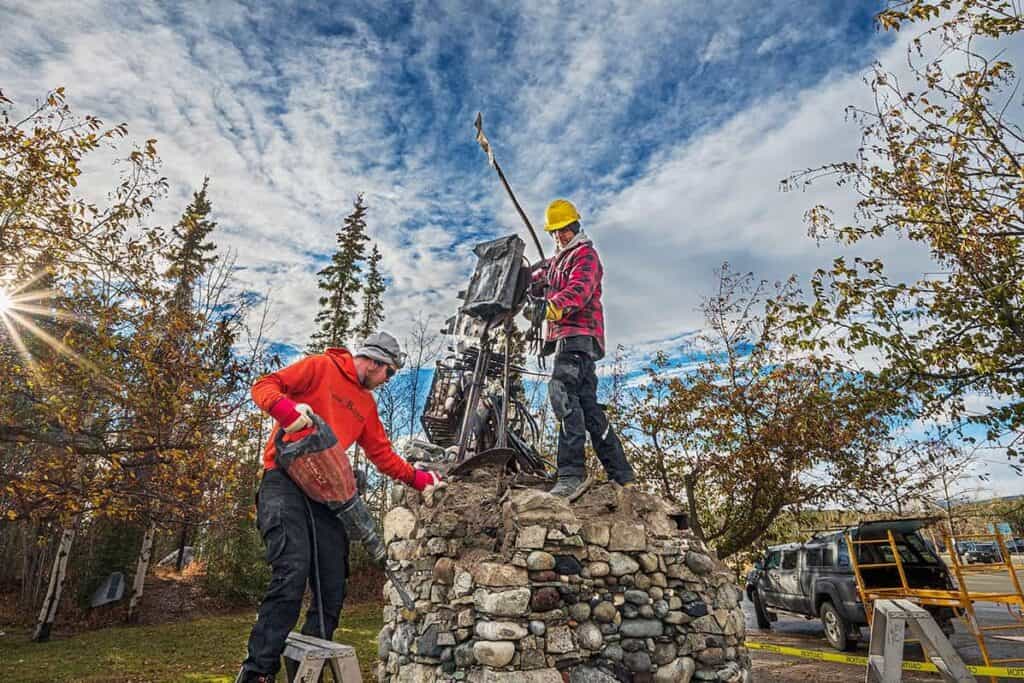Kelly Borgers considers herself a family photographer.
Except that her subject matter is not human faces, but Canada’s boreal forest.
“I probably have at least 15,000 pictures of the boreal,” she says.
“The pictures to me are little individual portraits. They show different little nuances of the forest, whether it’s a rock or a flower, or a cliff, or a waterfall. They’re all different portraits of the same family, called the boreal.”
The painter, photographer and teacher from Waterloo, Ontario has spent the past six summers driving remote logging roads and hiking backwoods trails, documenting the forest that she says connect Canadians from coast to coast.
Two weeks spent travelling the Dempster Highway and both the North and South Canol roads this August gave her the final ingredients she needed for a major exhibit that will debut November 10 at the Yukon Arts Centre gallery.
Borgers’ fascination with the northern forest was first sparked when a hiking companion and fellow artist invited her to visit the fly-in fishing camp in northern Ontario where she was working.
“That was my first discovery of the boreal, and then I realized I had to go further. So that’s how I ended up going from province to province to photograph.”
When Borgers first started showing some of her work, she soon realized how little people knew about the subject.
“That always surprised me the most, that people didn’t know, and they didn’t understand about their own forest in their own country.”
What drew Borgers was “just the sheer beauty” of the forest.
“I found it’s really similar from province to province… the shapes of the trees, and these sort of gnarly, comical Dr. Seuss-like trees that seem so typical of the boreal.”
The driving force for undertaking the ambitious photographic project was a “passion for conservation and protecting our own environment, and understanding how we can co-exist, human and nature,” she admits.
“Because we all want our cities, and we all want our cars and things like that. So how can we co-exist?”
While Borgers sees a striking family resemblance in forest areas from one end of the country to the other, there are also differences.
“When you look at some area that’s been clearcut and replanted, and an area that’s had a forest fire, they look very, very different,” she says.
“When you look at a forest-fire [area], there’s a lot of green, and there’s life and there’s wildflowers and there’s grasses coming up immediately.”
Not so with areas that have been logged.
“When I go back to some of the logging areas, the piles of slash are still there, and there’s been no reforestation. Some of the areas, it almost looks like a minefield,” she says.
“I’ve seen some areas where they’ve logged right to the watershed, and so a lot of erosion sets in, and that affects the water. There’s a lot of erosion, and not a lot of life in there. There’s not a lot of the green grasses and wildflowers.”
Even where reforestation has taken place, there are differences, she adds.
“There’s lots of trees that have been planted, but they’re all the same size and they’re all the same species of trees. There’s no diversity in there, so it looks like a prairie field planted with little trees.”
Still, Borgers isn’t opposed to logging, which she considers “potentially a very sustainable industry” if done properly. And she doesn’t consider herself an environmental missionary.
“I’m not one to tell people how to do something. I mean, I drive a pickup truck,” she laughs. “I should be bicycling through the boreal, but it doesn’t quite work that way.”
Instead, teacher that she is, she prefers a more indirect approach.
“I’m not there to preach what you should do, or how it should be done. To me, it’s about education and understanding and awareness.”
Her main tool for that purpose is art. In fact, she once had an exhibition that allowed viewers to read a Dr. Seuss book as they proceeded through the gallery.
“The images basically told the story that Dr. Seuss had told about the Lorax,” she says.
“It’s about a little boy who stumbles across a decimated forest, and he wants to know what happened. And so, I did an exhibition inspired by that.”
She considered it a compliment when one viewer wrote in the comment book, “Thanks for making me cry.”
Borgers wants the images in her new exhibition to tell a similar story.
“Because I’m an artist, I want them to speak visually. I want them to be able to provoke emotion and thought and feeling. If somebody leaves and thinks about something, then I think I’ve done my job as an artist. I don’t want to create the calendar picture.”
What she wants her viewers to think about is the importance of the huge, carbon dioxide-reducing expanse of boreal forest that spans the country.
“To me, it’s about people understanding the forest that’s in their own backyard, that’s part of them,” she says.
Her own fascination with Canada’s rugged backwoods puts Borgers in good artistic company.
As a painter, she was elected to the prestigious Ontario Society of Artists in 2000.
“I like to think if the Group of Seven were still around, we’d be going out to paint together, because that was the same group that they belonged to,” she quips.
For more information about her paintings and photography, go to http://kborgers.com/
The Boreal Portraits exhibition will be on display at the Yukon Arts Centre’s Public Art Gallery from November 10 to December 21.




